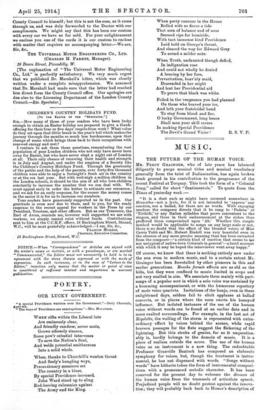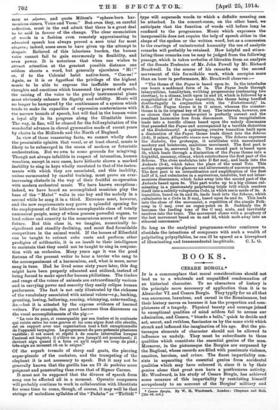MU SIC.
THE FUTURE OF THE HUMAN VOICE.
Ma. PERCY Gnattrarn, who of late years has laboured diligently to purge musical titles and musical vocabulary generally from the taint of Italianization, has again broken fresh ground in his contribution to the programme of the recent Festival at Torquay. This took the form of a "Colonial Song," called for short "Sentimentals." To quote from the Times of yesterday week :— "It is a duet such as might have occurred somewhere in Hiawatha—not a lyric, for it is not intended to 'express' any emotion, nor a ballad, for there are no words. With engaging, candour the composer directs that it be sung to 'Padaba' or 'Tiribidi,' or any Italian syllables that prove convenient to the singers, and these in their embarrassment at the riches thus proffered them compromised upon ' Ah.' Whether this simple method would be applicable to songs on any large scale or not, there is no doubt that the effect of the blended voices of Miss Carrie Tubb and Mr. Hubert Eisdell was very beautiful even in the absence of any more precise meaning than has been extracted from the composer—' a certain kind of emotion that seems to roe not untypical of native-born Colonials in general'—a lucid account with which it may be hoped the interviewer went away happy."
Of course, we know that there is nothing entirely new under the sun even in modern music, and to a certain extent Mr. Grainger has been forestalled by other pioneers in this and earlier generations. Bouche fermie effects are as old as the hills, but they were confined to music limited in scope and not very exalted in aim. We associate them mainly with part- songs of a popular sort in which a solo voice was sustained by a humming accompaniment, or with the humorous repertory of male voice quartets. Imitations of the banjo, even in these enlightened days, seldom fail to elicit applause at ballad concerts, or in places where the coon exerts big honeyed' influence. But isolated instances of the use of the human voice without words can be found at an earlier date and in more exalted surroundings. For example, in the last act of Bigoletto, the wailing of the storm is represented with extra- ordinary effect by voices behind the scenes, while rapid. bravura passages for the flute suggest the flickering of the lightning. But this stroke of genius, for so it unquestion- ably is, hardly belongs to the domain of music. It is a piece of realism outside the score. The use of the human voice as an instrument is a new thing. The redoubtable Professor Granville Bantock has composed an elaborate symphony for voices, but though the treatment is instru- mental, he has not dispensed with words. "Songs without words" have hitherto taken the form of instrumental composi- tions with a pronounced melodic character. It has been reserved for the present day to welcome the divorce of the human voice from the trammels of articulate speech. Prejudiced people will no doubt protest against the innova- tion; they will probably hark back to Homer's description of men as alpones, and quote Milton's "sphere-born har- monious sisters, Voice and Verse." But even they, on careful reflection, must in the end admit that there is a great deal to be said in favour of the change. The clear enunciation of words in a fashion even remotely approximating to educated speech has always proved a sore trial for moat singers ; indeed, some seem to have given up the attempt in despair. Relieved of this laborious burden, the human voice cannot fail to gain enormously in flexibility, and even power. It is notorious that when one wishes to attract attention at the greatest possible distance one seldom shouts a word, but generally ejaculates " Hi !" or, if to the Colonial habit native-born, " Coo-ee " Again, as it is ex hypotheei the privilege of the highest music to be able to express the ineffable moods and thoughts and emotions which transcend the powers of speech, the raising of the voice to the purely instrumental plane must obviously enhance its dignity and nobility. Music will no longer be hampered by the continuance of a system which tends to make its capacities of expression conterminous with the narrow bounds of speech, but will find in the human voice a loyal ally in its progress along the illimitable inane. The way, in fine, will be cleared for the full exploitation of the wonderful advance in choral gymnastics made of recent years by choirs in the Midlands and the North of England.
In view of these reassuring facts, we cannot wholly share the pessimistic opinion that vocal, or at least choral, music is likely to be submerged in the ocean of modern or futuristic orchestration. But we own to some grounds for misgiving. Though not always infallible in respect of intonation, human vocalists, except in rare cases, have hitherto shown a marked inability to sing in keys wholly unrelated to that of the instru- ments with which they are associated, and this inability, unless surmounted by careful training, must prove an ever- increasing obstacle in the way of their fruitful co-operation with modern orchestral music. We have known exceptions : indeed, we have beard an accomplished musician play the bass of the " Mabel " waltz in one key and the melody in a second while he sang it in a third. Extremes meet, however, and the new requirements may prove a splendid opening for the employment of the hitherto unemployable class of totally unmusical people, many of whom possess powerful organs, to lend colour and sonority to the momentous scores of the near future. But this class is, we imagine, numerically in- significant and steadily declining, and must find formidable competitors in the animal world. If the horses of Elberfeld can be taught to extract cube roots and perform other prodigies of arithmetic, it is an insult to their intelligence to maintain that they could not be taught to sing in conjunc- tion with an orchestra. Many years ago it was the good fortune of the present writer to hear a terrier who sang to the accompaniment of a harmonium, and, what is more, never sang in tune. Had he lived some sixty years later, this dog, might have been properly educated and utilized, instead of being forced to make sport for human philistines. The timbre and range of the voices of animals are extraordinarily various, and in carrying power and sonority they easily eclipse human performers. The fact is not only illustrated by the richness of the vocabulary associated with animal voices—e.g., barking, grunting, lowing, bellowing, roaring, whinnying, caterwauling, Jrc.—but it is attested by the express evidence of learned writers. For example, the great Larousse thus discourses on the vocal accomplishments of the pig:— "La oar du pore, si remarquable par eon timbre et le contrasts qui exists mitre lea sons graves et lea sons aigus dont elle results, est en rapport avec une organisation tout h fait exceptionnelle de l'appareil laryngien. Le grognement du ports presente plusieure varlet& : it eat sourd et repete it. de courts intervallee loraque l'animal est inquiet; s'elhve nn pen lorsqu'il est pourchasse; it devient sign quand il a faim on Tell regoit un coup de pied ;- tres-aign an moment oh on le saigne."
Of the superb tremolo of sheep and goats, the piercing super-piccolo of the cockatoo, and the trumpeting of the elephant it is not necessary to speak. But it may not be generally known that the gorilla has an St de poitrine more poignant and penetrating than even that of Signor Caruso.
It most not be supposed that the divorce of speech from song can be effected all in a moment. Operatic composers will probably continue to work in collaboration with librettists for some time to come, though, of course, it may well be that strings of melodious syllables of the "Padaba" or " Tiribidi "
type will supersede words to which a definite meaning can be attached. In the concert-room, on the other hand, we anticipate that the function of words will before long be confined to the programme. Musks which expresses the inexpressible does not require the help of speech either in the shape of the spoken or the written word, but as a concession to the cravings of uninstructed humanity the use of analytic remarks will probably be retained. How helpful and stimu- lating these remarks can be may be judged from the following passage, which is taken verbatim at literatim from an analysis of the Sonata Toutonica of Mr. John Powell by Mr. Richard Brockwell. In the course of his remarks on the second movement of this formidable work, which occupies more than an hour in performance, Mr. Brookwell observes :— "The theme of the Fugue is based upon 3o. In the interludes one hears a saddened form of la. The Fugue leads through labarynthine, tonalityless, writhing progressions (embracing two strettae), to a climax, built upon la and id, which is followed by a recapitulation of the Fugue exposition, the theme being handled double-fugally in conjunction with the • Einheitsmotif,' la. N.B.—The Fugue theme is in G minor, whereas the counter- theme is in its original key of E maj. The intervals, however, are so chosen that the counter-point is perfectly correct and the resultant harmonies free from dissonance. This recapitulation leads into a terrific climax based upon the unholy dissonance that preceded the Fugue and accompanied by a terrible distortion of the Einheitemotil. A squirming, evasive transition built upon a diminution of the Fugue theme leads direct into the Scherzo (3-8), B minor, Allegretto "'loam non troppo. The Scherzo expresses the diabolic, the grotesque, it ecintilates with unrestrained mockery and boisterous, malicious merriment. The first part is based upon 3a, answered by 3c. The second part is based upon 3b, which leads through a diminution of the Fugue theme into a frightful, uncanny, climax, which reintroduces the first part of the Scherzo. The close modulates into D flat maj., and leads into the Andante (3-4), which takes the plane of the usual Trio. This section expresses the glamour and allurements of amorous passion. The first part is an intensification and amplification of the first half of 3, and culminates in a mysterious, insoluble, but not inhar- monious dissonance, which fades away into the second part of the Andante based upon 3e. This part works up to a big climax cul- minating in a passionately palpitating triple trill which resolves itself into a sultrily voluptuous Coda, in which use is made of 3a. A transition, based on 3a and 3b, leads back into the Scherzo, which culminates in a Coda in B maj-, based upon 3a and 3c. This leads into the close of the movement, a repetition of the simple Folk- song in C maj. over an organ-point on. B. Suddenly the B becomes the leading tone of the C maj. scale, and inevitably resolves into the tonic. The movement closes with a prophecy of the last movement based on 4a and 3d, which melt away into an ethereal consonance."
So long as the analytical programme-writer continues to elucidate the intentions of composers with such a wealth of palpitating polysyllables, he canill be spared as a hierophant of illuminating and transcendental ineptitude. C. L. G.



























































 Previous page
Previous page